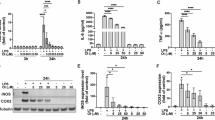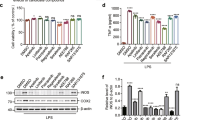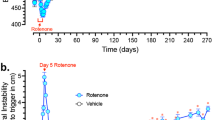Abstract
Inhibition of microglia-mediated neuroinflammation has been regarded as a prospective strategy for treating neurodegenerative disorders, such as Parkinson's disease (PD). In the present study, we demonstrated that systematic administration with iptakalim (IPT), an adenosine triphosphate (ATP)-sensitive potassium channel (KATP) opener, could alleviate rotenone-induced degeneration of dopaminergic neurons in rat substantia nigra along with the downregulation of microglial activation and mRNA levels of tumor necrosis factor-α (TNF-α) and cyclooxygenase-2 (COX-2). In rat primary cultured microglia, pretreatment with IPT suppressed rotenone-induced microglial activation evidenced by inhibition of microglial amoeboid morphological alteration, declined expression of ED1 (a marker for activated microglia), and decreased production of TNF-α and prostaglandin E2 (PGE2). These inhibitory effects of IPT could be reversed by selective mitochondrial KATP (mitoKATP) channel blocker 5-hydroxydecanoate (5-HD). Furthermore, pretreatment with IPT prevented rotenone-induced mitochondrial membrane potential loss and p38/c-jun N-terminal kinase (JNK) mitogen-activated protein kinase (MAPK) activation in microglia, which might in turn regulate microglial activation and subsequent production of TNF-α and PGE2. These data strongly suggest that the KATP opener IPT may be a novel and promising neuroprotective drug via inhibiting microglia-mediated neuroinflammation.
Similar content being viewed by others
Log in or create a free account to read this content
Gain free access to this article, as well as selected content from this journal and more on nature.com
or
References
Akundi RS, Candelario-Jalil E, Hess S, Hull M, Lieb K, Gebicke-Haerter PJ et al (2005). Signal transduction pathways regulating cyclooxygenase-2 in lipopolysaccharide-activated primary rat microglia. Glia 51: 199–208.
Alam M, Schmidt WJ (2002). Rotenone destroys dopaminergic neurons and induces parkinsonian symptoms in rats. Behav Brain Res 136: 317–324.
Ardehali H, O'Rourke B (2005). Mitochondrial K(ATP) channels in cell survival and death. J Mol Cell Cardiol 39: 7–16.
Arimoto T, Bing G (2003). Up-regulation of inducible nitric oxide synthase in the substantia nigra by lipopolysaccharide causes microglial activation and neurodegeneration. Neurobiol Dis 12: 35–45.
Bajgar R, Seetharaman S, Kowaltowski AJ, Garlid KD, Paucek P (2001). Identification and properties of a novel intracellular (mitochondrial) ATP-sensitive potassium channel in brain. J Biol Chem 276: 33369–33374.
Block ML, Hong JS (2005). Microglial and inflammation-mediated neurodegeneration: multiple triggers with a common mechanism. Prog Neurobiol 76: 77–98.
Bonetta L (2002). Pesticide-Parkinson link explored. Nat Med 8: 1050.
Busija DW, Lacza Z, Rajapakse N, Shimizu K, Kis B, Bari F et al (2004). Targeting mitochondrial ATP-sensitive potassium channels—a novel approach to neuroprotection. Brain Res Rev 46: 282–294.
Ciallella JR, Saporito M, Lund S, Leist M, Hasseldam H, McGann N et al (2005). CEP-11004, an inhibitor of the SAPK/JNK pathway, reduces TNF-alpha release from lipopolysaccharide-treated cells and mice. Eur J Pharmacol 515: 179–187.
Deutch AY, Winder DG (2006). A channel to neurodegeneration. Nat Med 1: 17–18.
Farkas E, Annahazi A, Institoris A, Mihaly A, Luiten PG, Bari F (2005a). Diazoxide and dimethyl sulphoxide alleviate experimental cerebral hypoperfusion-induced white matter injury in the rat brain. Neurosci Lett 373: 195–199.
Farkas E, Timmer NM, Domoki F, Mihaly A, Luiten PG, Bari F (2005b). Post-ischemic administration of diazoxide attenuates long-term microglial activation in the rat brain after permanent carotid artery occlusion. Neurosci Lett 387: 168–172.
Gao HM, Hong JS, Zhang W, Liu B (2002). Distinct role for microglial in rotenone-induced degeneration of dopaminergic neurons. J Neurosci 22: 782–790.
Gao HM, Liu B, Hong JS (2003a). Critical role for microglial NADPH oxidase in rotenone-induced degeneration of dopaminergic neurons. J Neurosci 23: 6181–6187.
Gao HM, Liu B, Zhang W, Hong JS (2003b). Novel anti-inflammatory therapy for Parkinson's disease. Trends Pharmacol Sci 24: 395–401.
Hansen JB (2006). Towards selective Kir6.2/SUR1 potassium channel openers, medicinal chemistry and therapeutic perspectives. Curr Med Chem 13: 361–376.
Helmuth L (2000). Pesticide causes Parkinson's in rats. Science 290: 1068.
Herrera AJ, Tomas-Camardiel M, Venero JL, Cano J, Machado A (2005). Inflammatory process as a determinant factor for the degeneration of substantia nigra dopaminergic neurons. J Neural Transm 112: 111–119.
Hirsch EC, Hunot S, Hartmann A (2005). Neuroinflammatory processes in Parkinson's disease. Parkinsonism Relat Disord 11 (Suppl 1): S9–S15.
Hu LF, Wang S, Shi XR, Yao HH, Sun YH, Ding JH et al (2005). ATP-sensitive potassium channel opener iptakalim protected against the cytotoxicity of MPP+ on SH-SY5Y cells by decreasing extracellular glutamate level. J Neurochem 94: 1570–1579.
Jenner P (2001). Parkinson's disease, pesticides and mitochondrial dysfunction. Trends Neurosci 24: 245–247.
Lacza Z, Snipes JA, Kis B, Szabo C, Grover G, Busija DW (2003). Investigation of the subunit composition and the pharmacology of the mitochondrial ATP-dependent K+ channel in the brain. Brain Res 994: 27–36.
Liss B, Haeckel O, Wildmann J, Miki T, Seino S, Roeper J (2005). K-ATP channels promote the differential degeneration of dopaminergic midbrain neurons. Nat Neurosci 8: 1742–1751.
Liss B, Roeper J (2001). Molecular physiology of neuronal K-ATP channels (review). Mol Membr Biol 18: 117–127.
Liu X, Wu JY, Zhou F, Sun XL, Yao HH, Yang Y et al (2006). The regulation of rotenone-induced inflammatory factor production by ATP-sensitive potassium channel expressed in BV-2 cells. Neurosci Lett 394: 131–135.
Lund S, Porzgen P, Mortensen AL, Hasseldam H, Bozyczko-Coyne D, Morath S et al (2005). Inhibition of microglial inflammation by the MLK inhibitor CEP-1347. J Neurochem 92: 1439–1451.
Minghetti L (2005). Role of inflammation in neurodegenerative diseases. Curr Opin Neurol 18: 315–321.
Nichols CG (2006). KATP channels as molecular sensors of cellular metabolism. Nature 440: 470–476.
O'Rourke B (2004). Evidence for mitochondrial K+ channels and their role in cardioprotection. Circ Res 94: 420–432.
Otani H (2004). Reactive oxygen species as mediators of signal transduction in ischemic preconditioning. Antioxid Redox Signal 6: 449–469.
Paxinos G, Watson C (1997). The Rat Brain in Stereotaxic Coordinates, Compact, 3rd edn. Academic Press: San Diego.
Perier C, Bove J, Vila M, Przedborski S (2003). The rotenone model of Parkinson's disease. Trends Neurosci 26: 345–346.
Rodrigo GC, Standen NB (2005). ATP-sensitive potassium channels. Curr Pharm Des 11: 1915–1940.
Sherer TB, Betarbet R, Kim JH, Greenamyre JT (2003). Selective microglial activation in the rat rotenone model of Parkinson's disease. Neurosci Lett 341: 87–90.
Waetzig V, Czeloth K, Hidding U, Mielke K, Kanzow M, Brecht S et al (2005). c-Jun N-terminal kinases (JNKs) mediate pro-inflammatory actions of microglia. Glia 50: 235–246.
Wang H, Zhang YL, Tang XC, Feng HS, Hu G (2004). Targeting ischemic stroke with a novel opener of ATP-sensitive potassium channels in the brain. Mol Pharmacol 66: 1160–1168.
Wang S, Hu LF, Yang Y, Ding JH, Hu G (2005). Studies of ATP-sensitive potassium channels on 6-hydroxydopamine and haloperidol rat models of Parkinson's disease: implications for treating Parkinson's disease? Neuropharmacology 48: 984–992.
Wang S, Hu LF, Zhang Y, Sun T, Sun YH, Liu SY et al (2006). Effects of systematic administration of iptakalim on extracellular neurotransmitter levels in the striatum of unilateral 6-hydroxydopamine-lesioned rats. Neuropsychopharmacology 31: 933–940.
West MJ (1993). New stereological methods for counting neurons. Neurobiol Aging 14: 275–285.
Wu J, Wakui M, Wang H, Hu G (2005). Iptakalim hydrochloride and neuronal protection. Curr Neuropharmacol 3: 249–256.
Xie W, Wang H, Ding J, Wang H, Hu G (2005). Anti-proliferating effect of iptakalim, a novel KATP channel opener, in cultured rabbit pulmonary arterial smooth muscle cells. Eur J Pharmacol 511: 81–87.
Yamada K, Inagaki N (2005). Neuroprotection by KATP channels. J Mol Cell Cardiol 38: 945–949.
Yamauchi T, Kashii S, Yasuyoshi H, Zhang S, Honda Y, Akaike A (2003). Mitochondrial ATP-sensitive potassium channel: a novel site for neuroprotection. Invest Ophthalmol Vis Sci 44: 2750–2756.
Yang Y, Liu X, Ding JH, Sun J, Long Y, Wang F et al (2004). Effects of iptakalim on rotenone-induced cytotoxicity and dopamine release from PC12 cells. Neurosci Lett 366: 53–57.
Yang Y, Liu X, Long Y, Wang F, Ding JH, Liu SY et al (2005). Systematic administration of iptakalim, an ATP-sensitive potassium channel opener, prevents rotenone-induced motor and neurochemical alterations in rats. J Neurosci Res 80: 442–449.
Yang Y, Liu X, Long Y, Wang F, Ding JH, Liu SY et al (2006). Activation of mitochondrial ATP-sensitive potassium channels improves rotenone-related motor and neurochemical alterations in rats. Int J Neuropsychopharmacol 9: 51–61.
Acknowledgements
This study was partly supported by a grant from the National Natural Science Foundation of China (Nos. 30625038, 30572172, and 30600758), a grant from the Key Project of Natural Science Foundation of Jiangsu Educational Department (Nos. 05KJA31014 and 06KJA31029), a grant from the Key Project of Jiangsu Health Department (No. K200501), and a Specialized Research Fund for the Doctoral Program of Higher Education of China (No. 20040312004).
Author information
Authors and Affiliations
Corresponding author
Additional information
DISCLOSURE/CONFLICTS OF INTEREST
There is no duality of interest that we should disclose.
Rights and permissions
About this article
Cite this article
Zhou, F., Wu, JY., Sun, XL. et al. Iptakalim Alleviates Rotenone-Induced Degeneration of Dopaminergic Neurons through Inhibiting Microglia-Mediated Neuroinflammation. Neuropsychopharmacol 32, 2570–2580 (2007). https://doi.org/10.1038/sj.npp.1301381
Received:
Revised:
Accepted:
Published:
Issue date:
DOI: https://doi.org/10.1038/sj.npp.1301381
Keywords
This article is cited by
-
Mechanisms underlying HIV-associated cognitive impairment and emerging therapies for its management
Nature Reviews Neurology (2023)
-
Ischemic postconditioning reduces spinal cord ischemia-reperfusion injury through ATP-sensitive potassium channel
Spinal Cord (2022)
-
Intranasal Exposure to Low-Dose Rotenone Induced Alpha-Synuclein Accumulation and Parkinson’s Like Symptoms Without Loss of Dopaminergic Neurons
Neurotoxicity Research (2022)
-
Microglia: Housekeeper of the Central Nervous System
Cellular and Molecular Neurobiology (2018)
-
Vitamin K2 suppresses rotenone-induced microglial activation in vitro
Acta Pharmacologica Sinica (2016)



